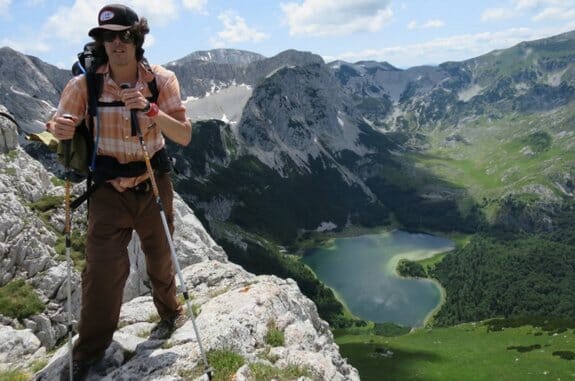Future Travel: Drawn to the Edge in the Western Balkans
Photos: Radojica Ćosović, Thierry Joubert
A forward-thinking cross-border collaboration between Bosnia and Herzegovina and Montenegro shines a light on one of Europe’s most beautiful regions.
![]()
The bordering municipalities of Foca and Plužine are in different countries—Bosnia and Herzegovina, and Montenegro respectively. That’s about where the differences end. What they share is one mountain-, lake- and river-strewn landscape, an ancient culture, and a combined reputation as the up-and-coming adventure-travel star here in the heart of Southeastern Europe’s Western Balkans.
To solidify that commonality, the two municipalities have launched an historic collaboration. The Tourism, Adrenalin, and Rafting Adventure project (T.A.R.A)—a responsible tourism partnership supported financially by the European Union—shines a spotlight on this border-straddling adventure hub. In doing so, it promotes the communities and strengths of each municipality while working to increase the overall success of both.
 Image: courtesy of Nature Park Piva
Image: courtesy of Nature Park Piva
These kinds of partnerships are uncommon in the world of international travel. Such an effort necessitates that each participant work for a greater good rather than convincing guests to stay in only one (their) country. The selfless and collaborative aim is to double the enjoyment for visitors, pool resources for locals and provide mutual support. The payoff for this forward-thinking philosophy can be filed in the “a rising tide raises all boats” category. The added benefit: a unified effort also means greater regional security for local tourism during uncertain times.
The idea of these two cross-border municipalities working together, however, is more than strategic. A partnership also magnifies the fundamental nature of healthy environmental values and sustainability. The region’s landscape—a haven for trekkers, climbers, kayakers, rafters, cyclists, horseback riding, bird- and wildlife-watching, and cavers—is as fragile as it is beautiful. The treasures sandwiched here between Bosnia and Herzegovina’s Sutjeska National Park and Montenegro’s UNESCO-inscribed Durmitor National Park include a rare primeval forest, the Nature Park Piva, glacial lakes, pristine rivers, and limestone mountains.
 Image: Radojica Cosovic
Image: Radojica Cosovic
In early autumn, I trekked across the municipalities with Thierry Joubert, the director of Green Visions, an eco-tourism operator based in Bosnia and Herzegovina. As we made our way along the Via Dinarica hiking trail, which links the two countries—walking over peaks, through villages, past shepherds with their flocks, and around clear, rushing streams—we could feel the vortex of energy that connects this stretch. It became clear a unified vision here must look beyond any artificial line man can draw on a map.
When we arrived at Dragan Šain’s stone guesthouse in the mountainous Montenegrin settlement of Sokolina, that sentiment was emphatically underlined. Dragan’s swath of earth seemed to float above the juncture where southeast Bosnia and Herzegovina meets northwest Montenegro. “The view from here is like having the best seat in the house at a concert,” Thierry said. “But in this case, the musicians are dramatic landscapes and panoramas covering two countries.”
In front of us, the Tara River Canyon, the second deepest gorge on the planet at 4,265 feet (only the Grand Canyon is deeper), dropped straight down and disappeared into a forest of firs, aspens, and beech trees. A deep velvet-green ocean, with splashes of orange and yellow, rolled across the land’s undulating contours in the crisp fall air. Due south and in the distance, the majestic and craggy Bobotov Kuk, the tallest summit in Montenegro’s Durmitor Range at 8,278-foot, speared the horizon. To the west, the Piva River Canyon was flowing into the electric-emerald waters of Piva Lake. Behind it, the 7,835-foot Mount Maglic, Bosnia and Herzegovina’s highest point stood guard over the famously heart-shaped Trnovacko Lake.
-

-

-

-

-

-

-

-

-

-

-

-

-

-

-

-

-

-

-

-

-

-

-

-

-

-

-

-

-

-

-

-

-

-

-

-

-

-

-

-

 Image:
Image:  Image: courtesy of Nature Park Piva
Image: courtesy of Nature Park Piva






































